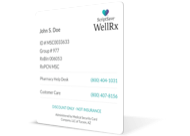Copyright 2024
Medical Security Card Company, LLC
All Rights Reserved
WellRx will never sell your personal information. Period. By signing up I agree to WellRx's terms of use and privacy policy.
by Robert “Jed” Swackhammer, Ohio State University
December 06, 2018
A patient recently had a primary care follow-up appointment with her physician. She was concerned about waking up during the middle of the night sweaty, shaky, and dizzy. The patient’s physician decided to decrease, her insulin dosage of Lantus, a long-acting insulin.
A few weeks later, the patient received a phone call from her community pharmacist regarding a refill gap on her insulin. The patient stated that her doctor decreased her dosage of Lantus due to low blood sugars in the middle of night. The pharmacist then asked, what insulin where you injecting in the evening? The patient responded, “My Humalog,” a rapid acting insulin.
The patient had been mistakenly taking her Humalog before bed without eating, but her doctor assumed she was using the Lantus, as prescribed. It was at this time the pharmacist counseled the patient on the differences between her insulins and the appropriate time to inject them. After concluding the phone call, the pharmacist advised the patient to follow-up with her physician if her blood sugars remained uncontrolled within a week. A month later, the patient called her community pharmacist to report her symptoms resolved and her blood sugars were controlled!
Currently, many healthcare professionals are having problems balancing the numerous responsibilities present in their day-to-day jobs. Consequently, this impacts patient care. A difficult and complicated question to ask is what should patients look for in a healthcare professional? The solution is to observe their willingness to work with all your healthcare providers. Consequently, it is important that your healthcare professional is an excellent communicator and prioritizes your needs.
Recent studies by BioMed Central Health Services Research identified 25 different patient-centered care models. The main takeaway from the study was patient-care models consisted of communication, partnership, and health promotion to meet the needs of patients.[1] Similarly, the Nursing Clinics of North America states that in order to improve quality of care in the United States, there needs to be continued focus on 6 dimensions: safe, effective, patient-centered, timely, efficient, and equitable.[2]
It’s vital that healthcare professionals (i.e. physician, nurse practitioner, physician assistant, pharmacist, psychiatrist, psychologist, dentist, cardiologist, endocrinologist, oncologist, and many others) work with one another so that you, as a patient, receive optimal care. With this collaboration, your healthcare team will be able to appropriately share information, deliver compassionate and empowering care, and consider the sensitivity of you as an individual while addressing your needs.[3]
With the aging Baby Boomer population, all healthcare professionals should appropriately equip themselves to focus on taking care of each patient individually instead of just isolated conditions. In dealing with the rise in our elderly population, the American College of Clinical Pharmacy states that “multiple articles have been published in support of clinical pharmacists’ involvement in patient-centered medical homes (PCMH) to help complete team‐based care, enhance patient access, transitions of care, and improve the quality and safety of patient-care”.[4] All professions have a unique position on this team, including pharmacists, because we all bring a different perspective and lens with which to view and treat our patients.
It is vital that all healthcare professionals work together to help deliver optimal patient care. As a patient, you can ensure that this by observing current and future healthcare professional’s ability to communicate with one another. Remember, communication is vital, so that you can be treated as a patient and your needs are addressed.
References:
[1] Bmchealthservres.biomedcentral.com. (2018). [online] Available at: https://bmchealthservres.biomedcentral.com/track/pdf/10.1186/1472-6963-14-271 [Accessed 27 Aug. 2018].
[2] Owens L, Koch R. Understanding Quality Patient Care and the Role of the Practicing Nurse. Science Direct. http://dx.doi.org/10.1016/j.cnur.2014.10.003. Published 2018. Accessed August 27, 2018.
[3] Bmchealthservres.biomedcentral.com. (2018). [online] Available at: https://bmchealthservres.biomedcentral.com/track/pdf/10.1186/1472-6963-14-271 [Accessed 27 Aug. 2018].
[4] Onlinelibrary-wiley-com.proxy.lib.ohio-state.edu. (2018). Shibboleth Authentication Request. [online] Available at: https://onlinelibrary-wiley-com.proxy.lib.ohio-state.edu/doi/abs/10.1002/phar.1357 [Accessed 27 Aug. 2018].

For your convenience, use the ScriptSave® WellRx mobile app. Now savings are well in hand, right at the pharmacy counter. Save on your family's prescription medicines.
Learn More
Your choice. Get a ScriptSave WellRx Savings Card. Or Download the free mobile app from the App Store or Google Play Store
Get A Card
ScriptSave WellRx Grocery Guidance leverages leading-edge nutritional data science to help you know which food products on your grocery store shelf are truly good for YOU.
Healthy Foods For YouTags:

June 09, 2022

April 26, 2022
You need to log into the site to use this feature
This feature requires registration. Sign up or log in to your free WellRx account to gain access to this and other tools to help make managing your medications and wellness easier.
Benefits Include:
 Store & manage your medication list
Store & manage your medication list
 Medication pricing updates
Medication pricing updates
 Medication information
Medication information
 Pill & refill reminders
Pill & refill reminders
 Medication journal & mood log
Medication journal & mood log
This feature requires registration. Sign up or log in to your free WellRx account to gain access to this and other tools to help make managing your medications and wellness easier.
Benefits Include:
 Store & manage your medication list
Store & manage your medication list
 Medication pricing updates
Medication pricing updates
 Medication information
Medication information
 Pill & refill reminders
Pill & refill reminders
 Medication journal & mood log
Medication journal & mood log
You will be redirected to your program in 5 seconds.
Our Terms and Conditions and Privacy Policy have recently been updated.
By declining you will be logged out of your account